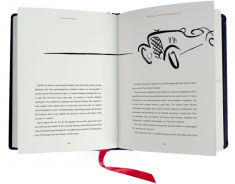October 22, 2013
A first edition shaken, not stirred
by Kirsten Reach
 Why do collectors pay so much for first editions of the James Bond books? In The Guardian, Rick Gekoski reports that the market for first editions by Ian Fleming occupy “an interesting and unparalleled place” in the market:
Why do collectors pay so much for first editions of the James Bond books? In The Guardian, Rick Gekoski reports that the market for first editions by Ian Fleming occupy “an interesting and unparalleled place” in the market:
I recently saw a copy of Casino Royale (the first novel) in beautiful condition offered at £50,000, and myself sold an equally pristine copy of Live and Let Die (the second) for £17,000… I do not know why prices of the Bond books have escalated so substantially over the past 30 years. Partly it is a market phenomenon: a lot more people read the Bond novels than Eliot or Woolf, and if a set percentage of the readership becomes collectors, there will always be more demand for the Bond books than those by highbrow literary writers. But the same is true of Barbara Cartland, and nobody collects her.
Perhaps collectors are in need of a figure they identify with, or are seeking objects of nostalgic value, Gekoski suggests. Bond is a hero, as well as an archetype.
As if to prove his thesis immediately, a first edition of Dr No donated to a Huntingdon charity shop sold for £600 last week. (It’s not just the Bond books that have value, of course: the Bond submarine recently sold for $860,000 to Tesla Motors CEO and PayPal co-founder Elon Musk.)
What is it about Bond that attracts so many readers and collectors? Is it the snappy one-liners? The cars? The ladies? The movies? Whatever it is, cartoon dollar signs seem to appear beside Bond’s name: the books have been reanimated by contemporary authors, and luxury editions of early Bond titles are cropping up this year around Bond’s sixtieth birthday.
Published in 1953, Casino Royale‘s birthday this year will be commemorated with a new edition from Vintage Classics and Bentley Motors. Copies will be illustrated by Damian Gascoigne, held together with a metal spine, and cost $1,200 a pop. Racing driver Sir Stirling Moss, who wrote the introduction to this edition, says, “When it came to cars Fleming really knew his stuff.”
The Bond series has endured other changes over the years, including a few writers since Fleming like Sebastian Faulks and Jeffery Deaver. The latest from William Boyd, titled Solo, is set during a civil war in the fictional country of Zanzarim, West Africa.
In a review of Solo for the Washington Post, Art Taylor explains, “To some degree… a Bond book is a Bond book. M, Q Branch, Miss Moneypenny, some fast cars, some fast women, a little globe-trotting, a little fate of the world in the balance — then shake, don’t stir. But as with the various shifts in the Bond franchise, small changes can make big differences.”
Jonathan Green begs to differ in the Sydney Morning Herald:
Fleming’s tales still purr with his easy driving flow, models of tightly plotted suspenseful fiction. The things most people take for the essence of Bond, the cars, the drinks, the clothes, the eggs, they’re all just embroidery really, adornments that were played up in the films and then reflected in the later books as Fleming began to draw on the 007 presented on the screen and threw some of that heightened cinematic character onto the printed page. The essence of the books is the tense thrill of the mission, circumstances that are never quite in Bond’s control, but always within the scope of his blind confidence.
Moreover, the character’s own confidence might inspire some confidence in accumulating value. In an interview last month, Don Stewart of MacLeod’s Books in Vancouver used Fleming as a prime example of the way people are drawn into book collecting: “Often they end up working their way up from a paperback Ian Fleming to hardcover and first edition Flemings and so they move, as their income permits, towards collecting something that has significant meaning for them.”
Kirsten Reach is an editor at Melville House.
